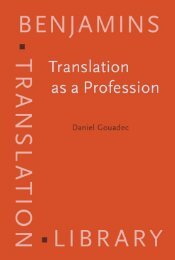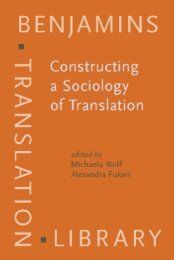Hermeneutics and Translation Theory.pdf
Hermeneutics and Translation Theory.pdf
Hermeneutics and Translation Theory.pdf
Create successful ePaper yourself
Turn your PDF publications into a flip-book with our unique Google optimized e-Paper software.
Iranian Translators Cyber Association Articles<strong>and</strong> on the level of narrative syntax; the semantic level (the content elements of the text); <strong>and</strong> thepragmatic or communicative context (addresser <strong>and</strong> addressee). In short, the first two dimensionsstress the structural features of texts <strong>and</strong> are concerned with their expression <strong>and</strong> content forms,whereas the other dimension stresses the signifying process <strong>and</strong> concentrates on analyzing theirgenerative processes <strong>and</strong> interrelations with other texts. (ibid) Armed with this theory, the 'textregime' holds their battleground rather strongly.Here the process of interpretation seems to end satisfactorily, yet the last step is indispensable,the involvement of the reader. Text ought not be treated as a closed formal network. Without thereader the meaning is not communicated. And if communication fails what follows naturally isthe failure of translation.The ReaderThis aspect does not attract attention until quite recently. Owing to the above schools theinterpretation of a certain work used to be looked on as fixed <strong>and</strong> established by authority whohave done thorough research about the author <strong>and</strong> the detailed analysis of the text at h<strong>and</strong>. Soany different interpretation tends to be strongly attacked, denying the fact that naturally differentreaders may well have different interpretations. To argue with persuasiveness, reception theory isintroduced in translation theory which is defined as the "approach to literature that concernsitself first <strong>and</strong> foremost with one or more readers' actualization of the text." (Lernout, 1994) Themost significant figure concerning this theory is Hans Robert Jauss <strong>and</strong> he is heavily quoted. The'reader regime' comes into prominence.Jauss's work in the late seventies, gathered in his Asthetische Erfahrung und literarischeHermeneutik in 1982 (the first part was issued in 1977 <strong>and</strong> translated into English as AestheticExperience <strong>and</strong> Literary <strong>Hermeneutics</strong> in 1982), moved toward a more hermeneutical interest inthe aesthetic experience itself. Jauss distinguishes three basic experiences: a productive aestheticpraxis (poiesis), a receptive praxis (aisthesis), <strong>and</strong> a communicative praxis (katharsis), <strong>and</strong> heclaims that a detailed study of these three elements can help literary history steer a coursebetween an exclusively aesthetic <strong>and</strong> an exclusively sociological perspective. Central in this newphase of Jauss's thinking is the third, communicative aesthetic praxis, which is defined as "the6
















